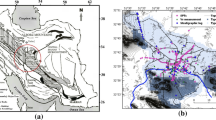Abstract
Potential sources are simplified as point sources or linear sources in current probabilistic seismic hazard analysis (PSHA) methods. Focus size of large earthquakes is considerable, and fault rupture attitudes may have great influence upon the seismic hazard of a site which is near the source. Under this circumstance, it is unreasonable to use the simplified potential source models in the PSHA, so a potential rupture surface model is proposed in this paper. Adopting this model, we analyze the seismic hazard near the Chelungpu fault that generated the Chi-Chi (Jiji) earthquake with magnitude 7.6 and the following conclusions are reached. ① This model is reasonable on the base of focal mechanism, especially for sites near potential earthquakes with large magnitude; ② The attitudes of potential rupture surfaces have great influence on the results of probabilistic seismic hazard analysis and seismic zoning.
Similar content being viewed by others
References
Abrahamson N A and Somerville P G. 1996. Effects of the hanging wall and footwall on ground motions recorded during the Northridge earthquake [J]. Bull Seism Soc Amer, 86(1B): S93–S99.
Aki K. 1968. Seismic displacements near a fault [J]. J Geophys Res, 73(16): 5 359–5 376.
Campbell K W. 1987. Predicting strong ground motion in Utah [R]//Gori P L and Hays W W. Assessment of Regional Earthquake Hazard and Risk along the Wasatch Front. Utah: U.S. Geological Survey Open File Report, 87-585, II, L-1–120.
Campbell K W. 1997. Empirical near-source attenuation relationships for horizontal and vertical components of peak ground acceleration, peak ground velocity and pseudo-absolute acceleration response spectra [J]. Seism Res Lett, 68(1): 154–179.
CHEN Pei-shan and BAI Tong-xia. 1992. Quantification relations between the source parameters [J]. Acta Seismologica Sinica, 5(3): 435–446.
CHEN Pei-shan, LI Bao-kun, BAI Tong-xia. 1998. Prediction of peak horizontal acceleration in the light of tectonic ambient shear stress field [J]. Chinese J Geophys, 41(4): 502–517 (in Chinese).
Geller R J. 1976. Scaling relations for earthquake source parameter and magnitude [J]. Bull Seism Soc Amer, 66(6): 1501–1523.
HU Yu-xian. 1999. The Tutorial of Seismic Hazard Assessment [M]. Beijing: Seismological Press: 293–302 (in Chinese).
HUAN Wen-lin and SHI Zhen-liang. 1993. The relations between the fault length and magnitude of strike-slip faults in China Mainland [C]//Proceedings of Seismic Zoning of China. Beijing: Seismological Press: 42–48 (in Chinese).
Institute of Geophysics of State Seismological Bureau. 1987. Chinese Earthquake Investigation [M]. Beijing: Seismological Press: 20–61 (in Chinese).
Kanamori H and Anderson D L. 1975. Theoretical base of some empirical relations in seismology [J]. Bull Seism Soc Amer, 65(6): 1 073–1 095.
Reiter L. 1991. Earthquake Hazard Analysis: Issues and Insights [M]. New York: Columbia University Press: 119–146.
Sadigh K, Chang C Y, Egan J A, et al. 1997. Attenuation relationships for shallow crustal earthquakes based on California strong motion data [J]. Seism Res Lett, 68(1): 180–189.
Schnabel P B and Seed H B. 1973. Accelerations in rock for earthquakes in the Western United States [J]. Bull Seism Soc Amer, 63(2): 501–516.
Shin T C and Teng Ta-Liang. 2001. An overview of the 1999 Chi-Chi, Taiwan, earthquake [J]. Bull Seism Soc Amer, 91(5): 895–913.
Wells D L and Coppersmith K J. 1994. New empirical relationships among magnitude, rupture length, rupture width, rupture area, and surface displacement [J]. Bull Seism Soc Amer, 84(5): 974–1 002.
XU Xi-wei, CHEN Wen-bin, YU Gui-hua, et al. 2002. Characteristic features of the surface ruptures of the Hoh Sai Hu (Kunlunshan) earthquake (M S8.1), Northern Tibetan Plateau, China [J]. Seismology and Geology, 24(1): 1–13 (in Chinese).
YU Yan-xiang and GAO Meng-tan. 2001. Effects of the hanging wall and footwall on peak acceleration during the Chi-Chi earthquake, Taiwan [J]. Acta Seismologica Sinica, 14(6): 654–659.
Author information
Authors and Affiliations
Corresponding author
Additional information
Foundation item: Joint Seismological Science Foundation of China (104065) and Social Public Welfare Special Foundation of the National Research Institutes (2005DIB3J119).
Contribution No.07FE3006, Institute of Geophysics, China Earthquake Administration.
About this article
Cite this article
Xü, Gy., Gao, Mt. Potential rupture surface model and its application on probabilistic seismic hazard analysis. Acta Seimol. Sin. 20, 302–311 (2007). https://doi.org/10.1007/s11589-007-0302-x
Received:
Accepted:
Issue Date:
DOI: https://doi.org/10.1007/s11589-007-0302-x
Key words
- potential seismic source
- fault rupture attitude
- potential rupture surface
- probabilistic seismic hazard Analysis
- seismic zoning




